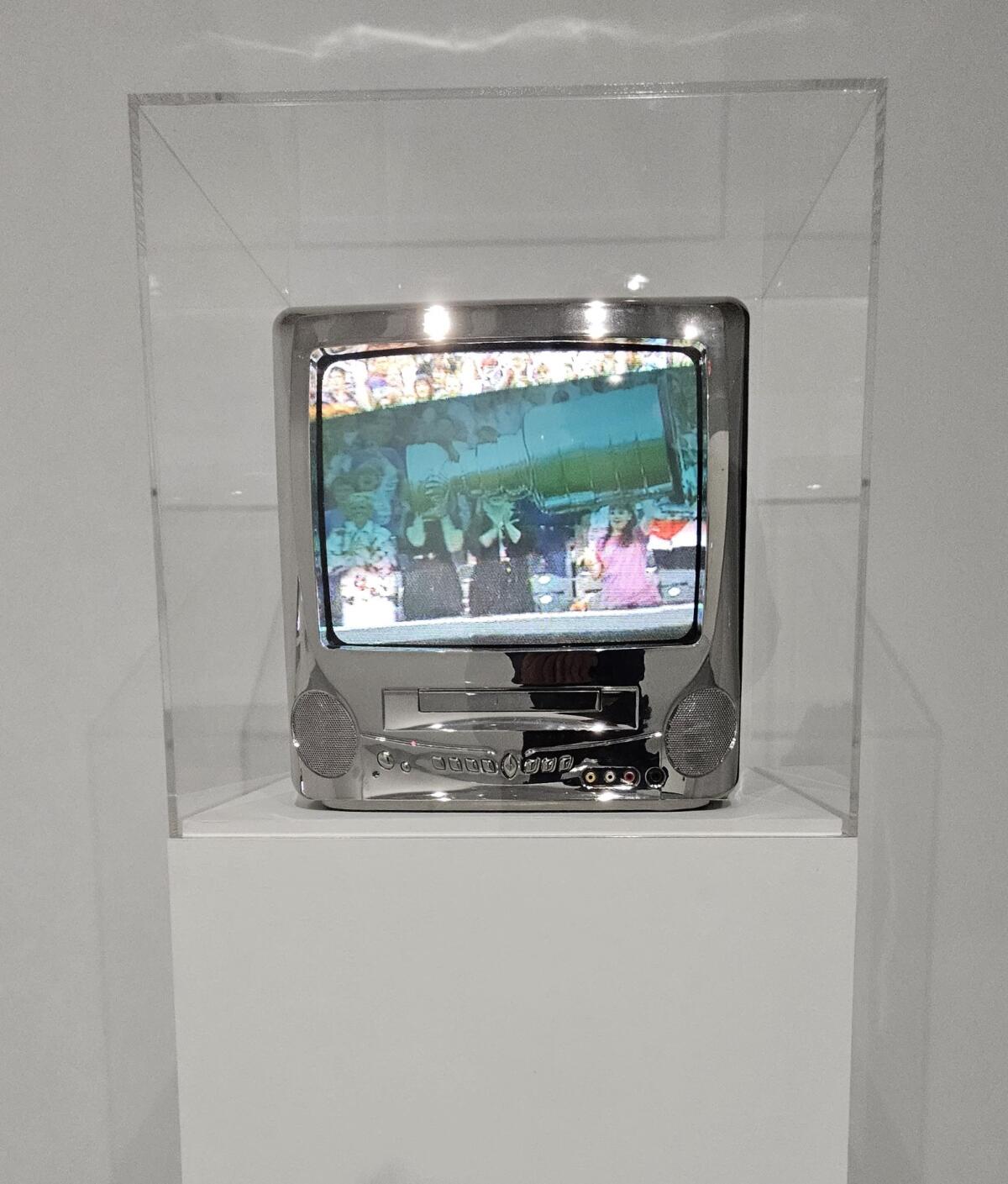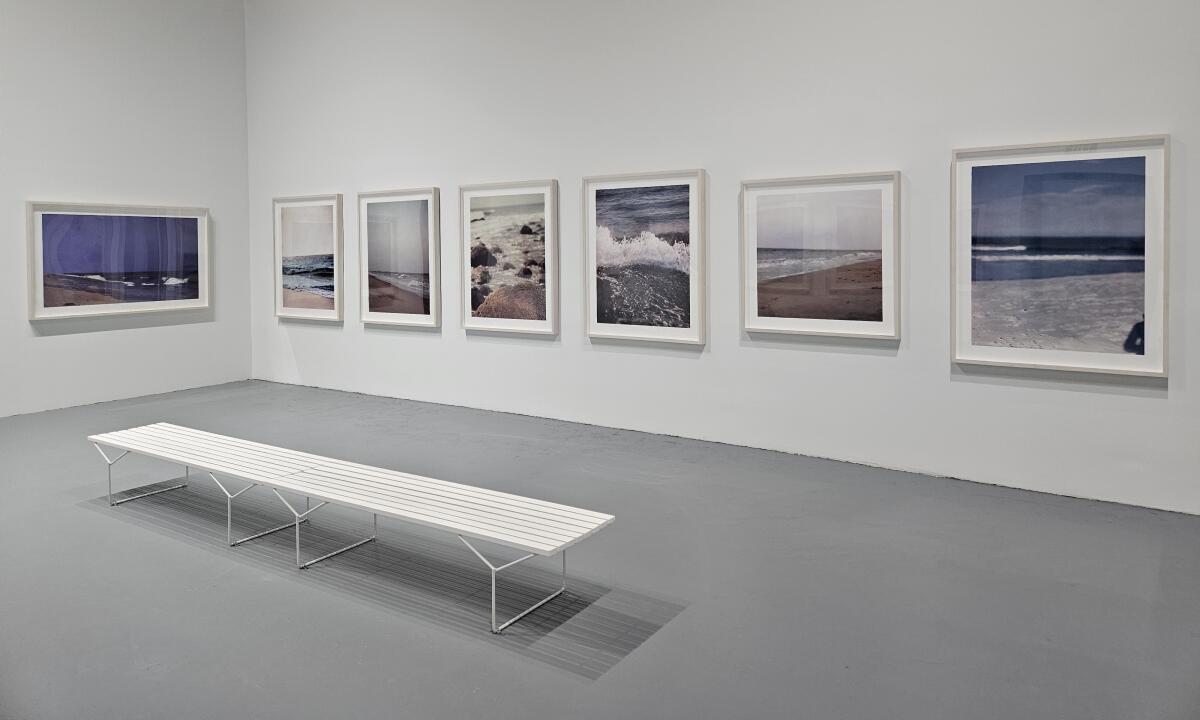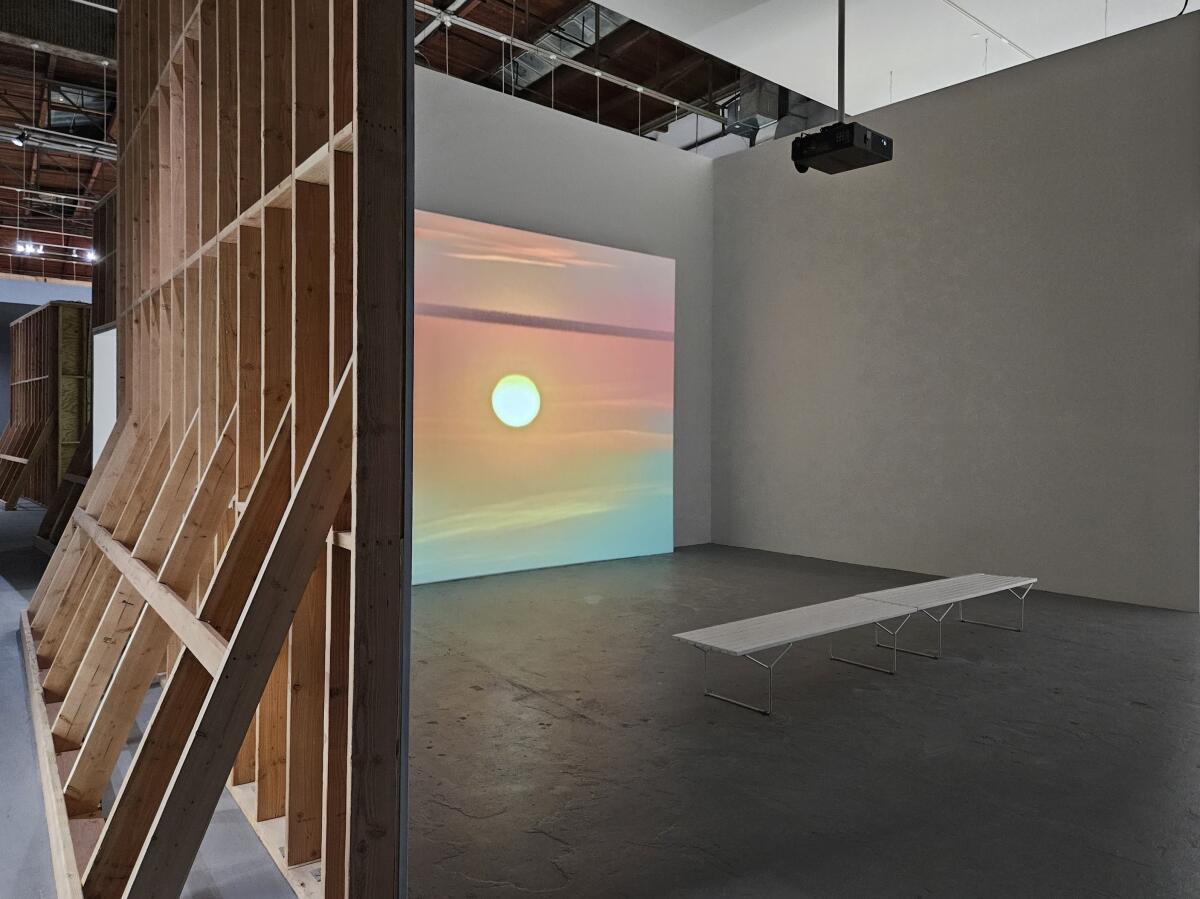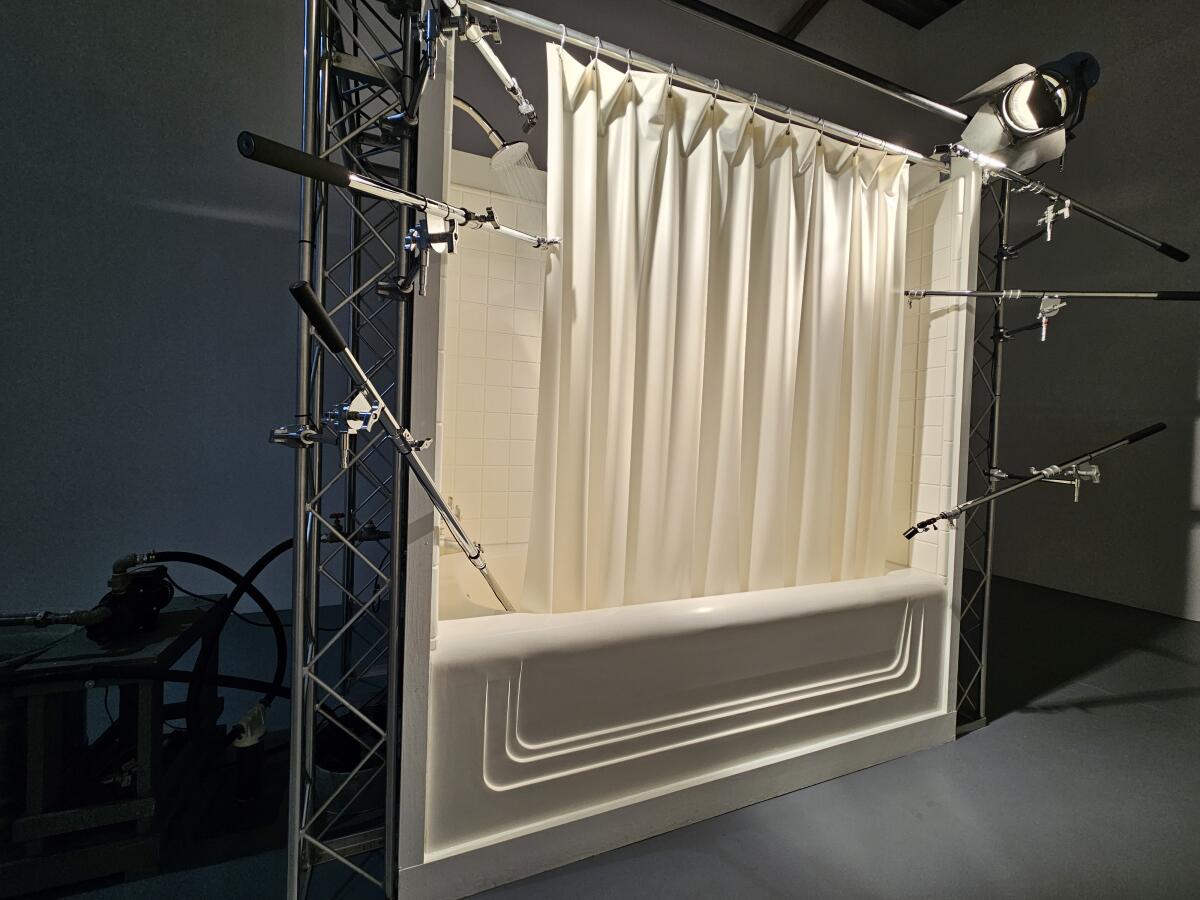Review: With sports and horror movies as canvas, an artist dissects the world’s digital upheaval

- Share via
Emotionally creepy, intellectually disturbing and very, very loud, both audibly and visually, “Paul Pfeiffer: Prologue to the Story of the Birth of Freedom” is an extraordinarily compelling survey of the artist’s work in digital imagery, whether sculptures that incorporate video, room-size installations or large-format photographs. He’s been at it since the mid-1990s.
The newly opened exhibition of more than 50 works at Little Tokyo’s Geffen Contemporary at the Museum of Contemporary Art is also timely, which adds to its resonance. We have lately been swallowed up in spectacular social and political upheaval, intensified by the depredations of digital life that traffics in images of state violence. With the eruptions and disruptions of digital mass culture as its Ferrari-level engine, often represented by the roaring drama of sport, Pfeiffer’s art cogitates on power as an ongoing campaign waged between the individual and the crowd.
Pfeiffer, 57, was born in Honolulu the year before French theorist Guy Debord published “Society of the Spectacle.” That thin but influential volume meditates on social transformations wrought by the corporate expansion of mass culture machinery, which has metastasized with the digital revolution. Debord is an unseen scaffolding for a hypnotizing work like “Caryatid,” in which the Stanley Cup — that big, heavy, tiered silver trophy awarded annually to the National Hockey League playoff champion — floats, bobs and twirls in space before a cheering crowd on TV.
Nothing is holding it up. The airborne trophy — the oldest that can be won by professional athletes in North America — appears to have a life of its own. It hovers before the throng like a preening drone, playful yet vaguely malevolent.
Pfeiffer digitally erased the athlete holding the monumental trophy aloft in stock video of the event, a ritualized gesture of triumphal victory. The century-old object, not the player, is isolated as the active factor in our human relationship to the sporting scene.

What makes the work more than a passing visual amusement, a TikTok trick of editing, is the carefully altered monitor on which it is shown. A silver 9-inch television, chrome-plated and as pristine as a Jeff Koons bunny, is revealed as its own objectified gesture of triumphal power, discreetly encased in a Plexiglas box and elevated atop a pedestal. Corporate digital media are the dynamic agents in modern social experience, inseparably playful and malevolent.
Just as the shiny television monitor echoes the glittery Stanley Cup, so a viewer is likened to the athlete digitally deleted from the “Caryatid” video — essential to, but erased from, the spectacle. In ancient Greece, the culture where male athletes were so highly prized as heroic citizens, a caryatid was a draped female figure used instead of a column as an architectural support. Sometimes a caryatid has been compared to the unseen slave who carried society’s burdens.
Pfeiffer, who is Filipino American, moved with his family to Manila when he was 10, early in the Marcos dictatorship, and he has since returned to live and work in the archipelago several times. (Mostly he’s based in New York.) Notably, the Philippines has been twice colonized — first for over 300 years by Spain and its Christian religion, then for half a century by the United States and its tumultuous mass culture. Both come into prominent play in the artist’s work.
An extraordinary 2015 photograph shows a Black basketball player seen from below, hovering in space in the middle of a vast stadium, enormous crowds packed into the stands and the lower portion of an American flag glimpsed hanging high overhead. No one else is on the court.
A fabrication? A digital manipulation of an actual moment? An erasure of elements to reveal something hidden but meaningful in our culture, in the tradition of Robert Rauschenberg famously erasing a Willem De Kooning drawing?

)
The player’s arms are extended like a crucifixion. His face obscured and his blank white uniform disclosing neither team nor number, he is resolutely anonymous — as anonymous as the throng ogling in the stands. He seems held aloft by the sheer force of a mass performance.
The photograph is one in a group titled “Four Horsemen of the Apocalypse,” a reference to the prophecy of triumph and submission from the New Testament Book of Revelation. Spectacle and spectatorship, cruelty and liberation are embedded in a scene poised on the brink of an individual soul’s ultimate destiny. So is the promise of a second coming, which is not necessarily consoling. The image of Black resurrection through b-ball is at once celebratory, chilling and poignant.
Pfeiffer takes on big themes. In “John 3:16” (2000), the image focuses on a basketball, a talisman that completely fills the screen and bobs around as it is being passed between largely unseen players. Sometimes hands come into view, at other times there is only the spinning, ricocheting ball. It’s akin to the levitating Stanley Cup in “Caryatid,” made three years later.
Artist Barbara T. Smith, 92, gets her first museum retrospective, at the Institute of Contemporary Art, Los Angeles.
Also like “Caryatid,” the monitor matters. Here it’s a little 5½-inch LCD screen, which is mounted at the end of a three-foot armature that thrusts out from the wall maybe seven or eight feet above the floor. Think aggressive intimacy, which marks much of Pfeiffer’s disquieting work. Here you look up to the image, but close scrutiny is impossible; only deference is. The biblical title, “John 3:16,” identifies the digital revolution as holding the crucial modern mystery of eternal life. Its only commandment: Stay tuned.
Ancient mythologies, sacred and profane, run throughout Pfeiffer’s exhibition, organized by MOCA chief curator Clara Kim and assistant Paula Kroll. Climb an elaborate circuit of stairs to reach the top of an enormous, room-filling platform, “Vitruvian Figure” (2008), and you arrive at the nosebleed level above a massive model of a huge football stadium hollowed out below. You’ve seen such a place in person or on TV a thousand times — today’s version of Rome’s ruined Colosseum, a now-corporate rather than imperial place for public spectacles and gladiatorial contests. The stadium’s concentric rings turn the form into something between a target and a drain.

Or see a suite of 24 large-scale photographs of the seashore, made from existing publicity photographs of Marilyn Monroe frolicking at the beach. She’s our postwar Venus, goddess of love and beauty, rising Botticelli-like from the sea.
Except she’s not there. The beach photos digitally erased Marilyn to leave only the varied coastlines in view. They’re conceptually smart, but visually uninteresting. The form isn’t always successful.
Their Marilyn subject does acknowledge Pfeiffer’s engagement with the 1960s legacy of Andy Warhol. (When Pfeiffer was born in 1966, Warhol’s art was at the peak of its power.) So does “Morning After the Deluge” (2003), which echoes Warhol’s unfinished film, “Sunset,” and builds on a nearly abstract 19th century seascape painting by J.M.W. Turner. Shot on Massachusetts’ Cape Cod, site of the 1620 Mayflower arrival, the “Deluge” composite image is an overlay of the sun rising and setting simultaneously in rapturous colors over a bay that opens into the Atlantic Ocean. The magnificent wall-size projection is one of the few digital scenes the artist photographed himself.
Erasure remains a key element: In the digital fusion, the Earth’s stable horizon visually disappears. At the pivotal place where North American culture supposedly left Europe behind, the glowing sun is dreamily adrift. Gorgeous shifting light floats for more than 20 minutes without an earthly anchor. Pfeiffer titled the work with a biblical reference to the flood in Genesis, another hungering for rebirth by way of epic disaster.
In a wall text for “Morning After the Deluge,” the artist is quoted as identifying the horizon — now gone in his projection — as the location of the vanishing point in traditional art’s use of one-point perspective, brainchild of the Renaissance. The fixed vanishing point, where all lines of vision converge, corresponds to a viewer standing before the picture, motionless in time and space. His video composition is an acute metaphor of the disorienting shift from an analog world into a digital one, a deluge underway now for several tumultuous decades.

Perhaps to amplify the difference between analog and digital, the show’s savvy installation goes all-in on emphatic materiality. Rooms have been built inside the museum’s big warehouse space, their raw construction from 2-by-4s, metal braces and drywall left flagrantly exposed. No expense was spared, which might explain the exhibition’s absurdly long run — it closes in June, after seven months — and a catalog disappointingly delayed until March. (There’s also an admission premium of $10 to $18.) Museum galleries are always stage sets for theatrical displays of art, but this show insists on keeping that in mind.
One room houses “Live From Neverland” (2006), a terrifying video projection in which 84 Filipino children, half boys and half girls, all dressed in traditional white barong Tagalog shirts and long white terno dresses, file into rows on bleachers as if in a church choir or a school assembly. They recite in unison the dissembling monologue Michael Jackson read on national television to deny allegations of child molestation in 1993, a speech that plays simultaneously on a monitor placed on the floor. Jackson’s image glows blood-red, then flips to a television test pattern as the kids file out into the world.
By the time you come upon “Self-Portrait as a Fountain” (2000), an elaborate sculpture whose composition of an actual bathtub, lights, microphones, cameras and recycling water carefully re-creates the murderous shot-by-shot shower scene from Alfred Hitchcock’s “Psycho,” you’ll be forgiven for thinking immediately of Donald J. Trump. Like “Live From Neverland,” repetition of a media fiction creates reality. The former president later did as much, blithely reciting to a graduating class at Liberty University, a school founded by a fundamentalist televangelist, unattributed dialogue from the political satire “Legally Blonde,” or just last week spurting Nazi rhetoric on social media, cribbed from “Mein Kampf.”
Another work, “The Saints” (2007), expands that chill of mass media indoctrination into a very large room, painted blinding white and apparently empty, save for a dozen vertical white speakers that ring the space. The roar of an unseen crowd blares, a deafening noise that rises and falls in enveloping waves. Glimpsed on a freestanding wall at the far end of the room is a tiny LCD screen, on which a lone player is seen roaming a soccer field — quite like you are doing in the big room. Tucked around behind the wall are two side-by-side video projections, one showing the football game and the other a frenzied, bellicose crowd.

“The Saints” restages the audience response to the controversial 1966 World Cup soccer final between West Germany and England in London’s mammoth Wembley Stadium, about which fervent fans still heatedly argue today. Pfeiffer hired 1,000 Filipinos to fill a Manila movie theater, where they cheered in accompaniment to original film and sound materials from the event, whose winner and loser were disputed. With its thumping 17-channel audio enhancement, “The Saints” is a portrait of fevered human sound, an installation that peels the digital onion.
Your eyes might begin to water, your head to throb and headlines in today’s newspapers to overwhelm your thoughts. “Fascism sees its salvation in giving these masses not their right, but instead a chance to express themselves,” wrote Walter Benjamin of the surreptitious propaganda power of camera reproduction in 1935, as authoritarianism made its lethal march across Europe. With skill and discernment, Pfeiffer’s art probes the formidable aesthetic now, amplified by the digital revolution.
Geffen Contemporary at MOCA, 152 S. Central Ave., Little Tokyo, (213) 621-2766, through June 16; Closed Monday. moca.org
More to Read
The biggest entertainment stories
Get our big stories about Hollywood, film, television, music, arts, culture and more right in your inbox as soon as they publish.
You may occasionally receive promotional content from the Los Angeles Times.












